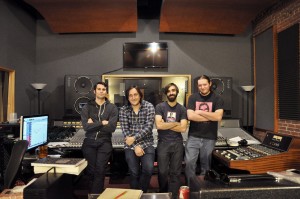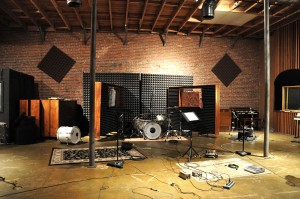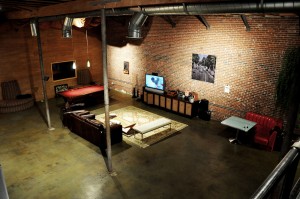The Fortress: Out-of-the-Box Recording In Downtown LA
Downtown Los Angeles has seen a metamorphosis in recent years; bringing new clubs, restaurants and other businesses to a neighborhood that went neglected for a very long time. In a city that tends to tear down any building over 50 years old and erase its history (the sad fates of The Ambassador Hotel and The Brown Derby exemplify this trend), it’s a pleasant surprise to find an older structure be preserved and transformed into a comfortable, creative environment. Such is the case of The Fortress, a beautiful, new recording studio just east of downtown’s commercial district.
Once a soap factory, the spacious, hundred-year-old brick structure was home to the Stone Temple Pilots for over a decade. With a large, high ceilinged tracking room, an impressive control room and a huge lounge, it was a natural choice for musician Mykul Lee, who bought the building (then known as “The Bomb Shelter”) and its resident Solid State Logic console from STP drummer, Eric Kretz in the spring of 2012.
While working in a commercial Hollywood studio, Lee had suggested the possibility of buying and operating a facility to producer/engineer, Max Coane. The two began to look around, even considering buying a house in nearby Sherman Oaks, gutting it and turning the whole structure into a studio. And then…
“All of a sudden this place was up for sale,” tells Coane, “We kind of didn’t believe it. We came and looked at it and said we’re never going to find something that has this much of a build-out already, we should come in and try to pick up as much of the gear as we can. We bought the SSL, the patchbays and all of the associated wiring and that saved us a bunch of time moving in.”
Turning up with a mountain of their own gear, a large-scale install was in order and Audrey Wiechman of Electricia Studio Services handled the wiring duties. “It’s been a work in progress,” Coane says, “There’s a great community of musicians that we’re friends with and everybody threw their gear into the studio. We have five or six drum kits, two organs, two pianos, tons of amps, mics, guitars, keyboards… everything you need to make a record.”
The SSL 4048 G+ console featuring 48 channels (96 inputs including the monitor faders) with Total Recall and VCA automation, was originally sold to Mirror Image Recording in NYC. It made its way to Eric Kretz’ home and finally to the studio where it is the centerpiece today. A vintage Neve sidecar loaded with 1063 modules accompanies the SSL.
“The Neve was built for Shelly Yakus in the 70s, it sounds awesome and we actually modded it, adding four busses. Originally it didn’t have any buss amps at all, now it has 1272s and 34115s, so you can pick between a couple of different sounds, depending on what you’re going for.”

At The Fortress (l-r): Adam Lathrum , Max Coane, Brian Harris, Alex Moculeski. Photo by Cian Riordan.
A huge pair of Urei 813 main monitors frames the control room glass and an impressive arsenal of outboard gear fills the credenza directly behind the mix position, including a matched pair of Pultec equalizers.
The sheer size of the lounge is the first thing one notices when walking into the building. A machine room, which houses the SSL power supplies and amps for the studio’s monitoring, and a large iso booth flank the entrance to the control room. Although the iso booth shares the same ceiling height as the adjacent live room, it has a fabric drop ceiling creating a cozy effect and offers another great space for tracking drums.
The Fortress currently runs Pro Tools 10 and the I/O configuration consists of Apogee Symphony converters with an Antelope Audio Isochrone Trinity master clock. Sometimes mixes are printed to analog ½”, in which case an Ampex ATR-102 is utilized, but for the most part mixes are recorded back into Pro Tools with the last four channels of Apogees calibrated at specific level sets to send to the mastering engineers.
The selection of gear from the Neve to the outboard compressors and surprisingly few plug-ins says something about the old school recording philosophy at work in The Fortress, that is to keep it “out of the box.” That includes utilizing the console’s inserts and most importantly, the regular use of room mics, putting the unique sound of the space into the recordings made there.
Chandler Harrod, an engineer very involved in The Fortress’ community proclaimed early on, “We’re never using digital reverb again in this studio.” Coane pointed out that Motown and Sun, for example, were known for their rooms being central to their signature sounds. That being the case, they have a beautiful AKG C24 and a pair of Neumann KM 53s that are in heavy use all the time.
Of course, the same sort of approach applies to the music and live performances. The studio is ideally suited for rock and pop performed by musicians playing together in the room. Considering the selection of instruments on hand and the musician community involved, it’s not surprising that one of the studio’s ongoing projects is “The Fortress Social Club” with Mykul Lee and Shawn Harris.
“Everybody involved in the studio in one way or another has played on this record,” says Coane, “It’s all these retro 60s soul songs – it’s fun.” Other recent projects include No Doubt, who was in cutting drums and Christina Perri who was in with her band writing for her upcoming record.
The lounge has a pool table, a full kitchen and, of course, a comfortable sofa seating area that invites collaboration. While downtown Los Angeles continues to be redefined as a part of town with appealing restaurants and coffee shops, The Fortress finds itself in good company and no doubt has a decent local menu book (a studio necessity) to choose from something that wasn’t quite possible ten years ago in that neighborhood.
While The Fortress is regularly busy with the musicians and engineers who make up the friendly crew, the studio is available for booking. Visit http://www.thefortressla.com, twitter.com/maxcoane or call 213-622-0371.
Michael Westbrook is a studio technician in Los Angeles specializing in building custom and unusual mixing consoles.
Please note: When you buy products through links on this page, we may earn an affiliate commission.









Max
January 23, 2013 at 12:51 pm (12 years ago)Thanks for the writeup of our little studio!